There are many statues on the Hawk Hill campus, both old and new. Some have held their place on campus since the early days of the university, while others are no more than 10 years old. Each statue tells a story about our St. Joe’s community past and present. Here are stories from some of Hawk Hill’s statues.
Synagoga and Ecclesia in Our Time
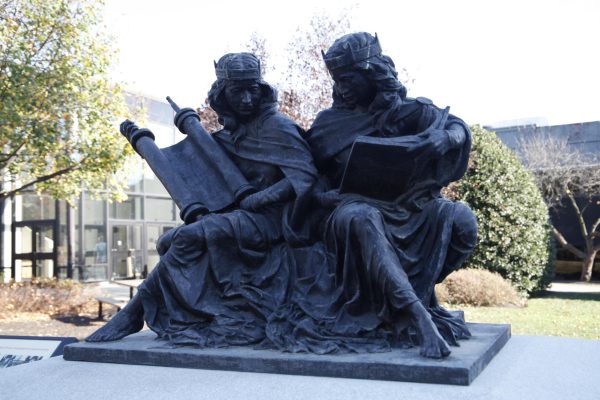
Located outside the Chapel of Saint Joseph, “Synagoga and Ecclesia in Our Time” is best known for being blessed by Pope Francis in 2015, the same year it was installed.
The statue portrays two figures sitting together, each displaying their religion’s holy text for the other to view. The figure on the left holds a Jewish Torah scroll, while the figure on the right holds the Catholic Bible. The sculpture, made out of bronze, was created by Philadelphia-based sculptor Joshua Koffman.
Synagoga (“Synagogue”) and Ecclesia (“Church”) were common symbols found in medieval Christian art and refer to the personification of Judaism and the Church as female figures. Historically, Ecclesia (Christianity) was portrayed as a revered, dignified and victorious figure with a crown, while Synagoga (Judaism) was portrayed as inferior, broken and uncrowned.
Adam Gregerman, Ph.D, professor of theology and associate director of the Institute for Jewish-Catholic Relations, was a key figure in commissioning the statue.
“What we decided to do is play with those images by using them, but inverting the meaning, and to emphasize not triumph [of] one over the other, but rather something with a sense of shared dignity and status,” Gregerman said.
Our Lady of Grace
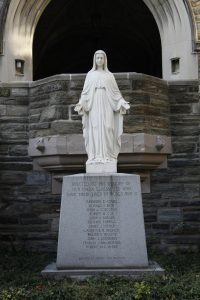
Found in Barbelin Hall’s quadrangle, this statue of the Blessed Mother was erected in 1947 to serve as a memorial to a St. Joe’s class of 1943A alumni who died in WWII. Following the attack on Pearl Harbor, St. Joe’s created an accelerated program for students so young men could receive their degrees before being drafted. Under the accelerated program, each graduating class was split into A and B sections. The class of 1943A graduated in the winter, while 1943B graduated in the spring.
The statue is a depiction of the Blessed Mother, known specifically as “Our Lady of Grace.” This depiction of Mary is shown with her arms outstretched in order to signify her role as an intercessory figure.
The class of 1943A was hit the hardest in the war, losing 12 men whose names are now engraved on the Our Lady of Grace statue. In 1947, Barbelin Hall was the only building on the St. Joe’s campus, so placing the statue in this courtyard provided them a prominent place for remembrance.
The Presidents’ Faces
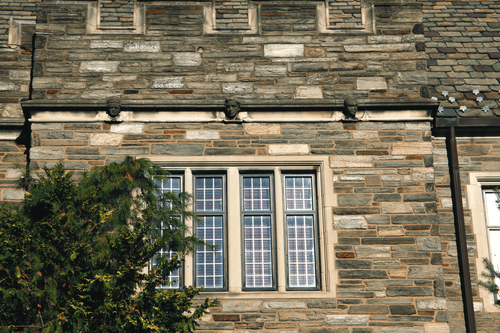
Sculpted into the north and east cornices of the Barbelin Hall’s quadrangle are eight of the 13 Jesuit presidents who served St. Joe’s between 1851 and 1927. The limestone portraits were modeled on period photographs and depict the unique likeness of each president. St. Joe’s founder and first president, Felix Barbelin, S.J., is seen among the sculptures wearing a surplice, a preaching stole and a biretta, a square cap worn by clergy members.
Carmen Croce ’71, director of the university press, said the busts serve as admonitors for the current president. The Jesuits used to assign to the president an admonitor who was an older, wise fellow Jesuit connected to the university, Croce explained. The admonitor’s role was to advise, or admonish, the president with honesty and confidentiality.
“They act as silent admonitors,” Croce said. “They were looking down at whatever was going on, and as the president looked up, he would see these people looking down on him, and he’d be on his best behavior.”
The Pilgrim
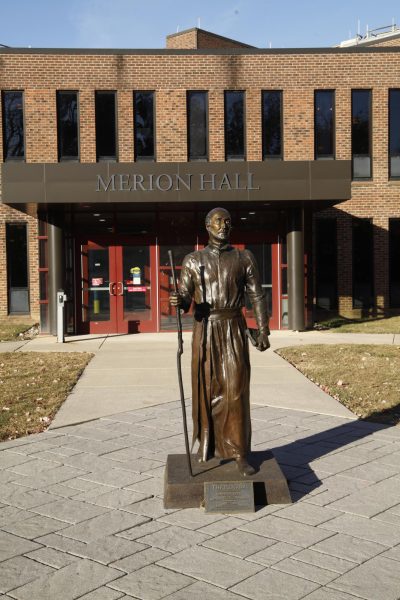
Located outside Merion Hall, “The Pilgrim” depicts the founder of the Jesuit Order, St. Ignatius of Loyola. In his 1643 autobiography, Saint Ignatius refers to himself as a pilgrim on his journey to the Holy Land, Jerusalem. The bronze statue was created by Missouri-based sculptor Vicki Winters-Reid and installed on campus in 2011.
It is common for Jesuit universities to have a depiction of Saint Ignatius somewhere on their campus, though the depiction of Saint Ignatius as a pilgrim was a choice made by Croce.
“It applies to all of us because you may not be walking in a pilgrimage like he did to the Holy Land, but you’re constantly moving and responding to opportunities that come up,” Croce said. “And that’s the message of Saint Ignatius, the Pilgrim: that you have to be open to opportunities that come along, and you can’t be afraid to seize the day.”
The original placement of the statue was cause for some debate, according to Croce.
“They wanted the saint against the wall, and I said, ‘No, no. If he’s Ignatius, the Pilgrim, he’s got to be walking, and he’s got to be walking amongst us.’”
Armillary Sphere
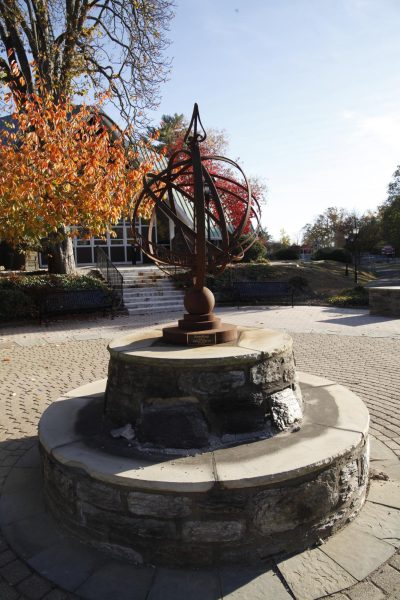
The Armillary Sphere, located next to Connelly Hall, is one of several pieces on the Hawk Hill campus created by John R. Post ’60. Post is the benefactor and namesake of several Hawk Hill campus structures, including the newly constructed Post Crossing. In addition to his monetary contributions to the school, Post is also the founder of Post Precision Castings, Inc., a custom manufacturer of investment castings.
Post’s passion for metalwork led him to create such pieces as the Armillary Sphere on campus. When Post offered to donate pieces to the campus, Croce selected the Armillary Sphere to liven up the space. It was installed in November 2013, Croce said.
The Armillary Sphere is an old astronomical instrument composed of rings showing the positions of important circles of the celestial sphere. In relation to the saints, the Armillary Sphere has been used as an emblem to represent contemplation of heaven.
“It was just this blank space waiting for something of interest,” Croce said.














































